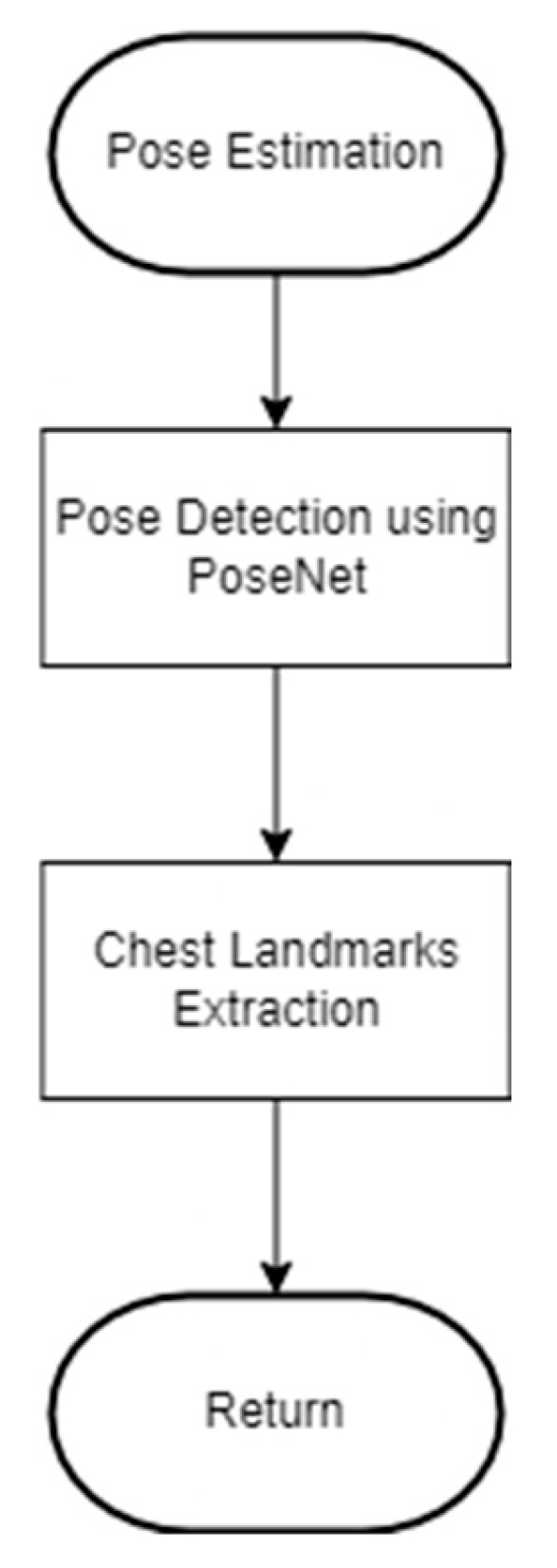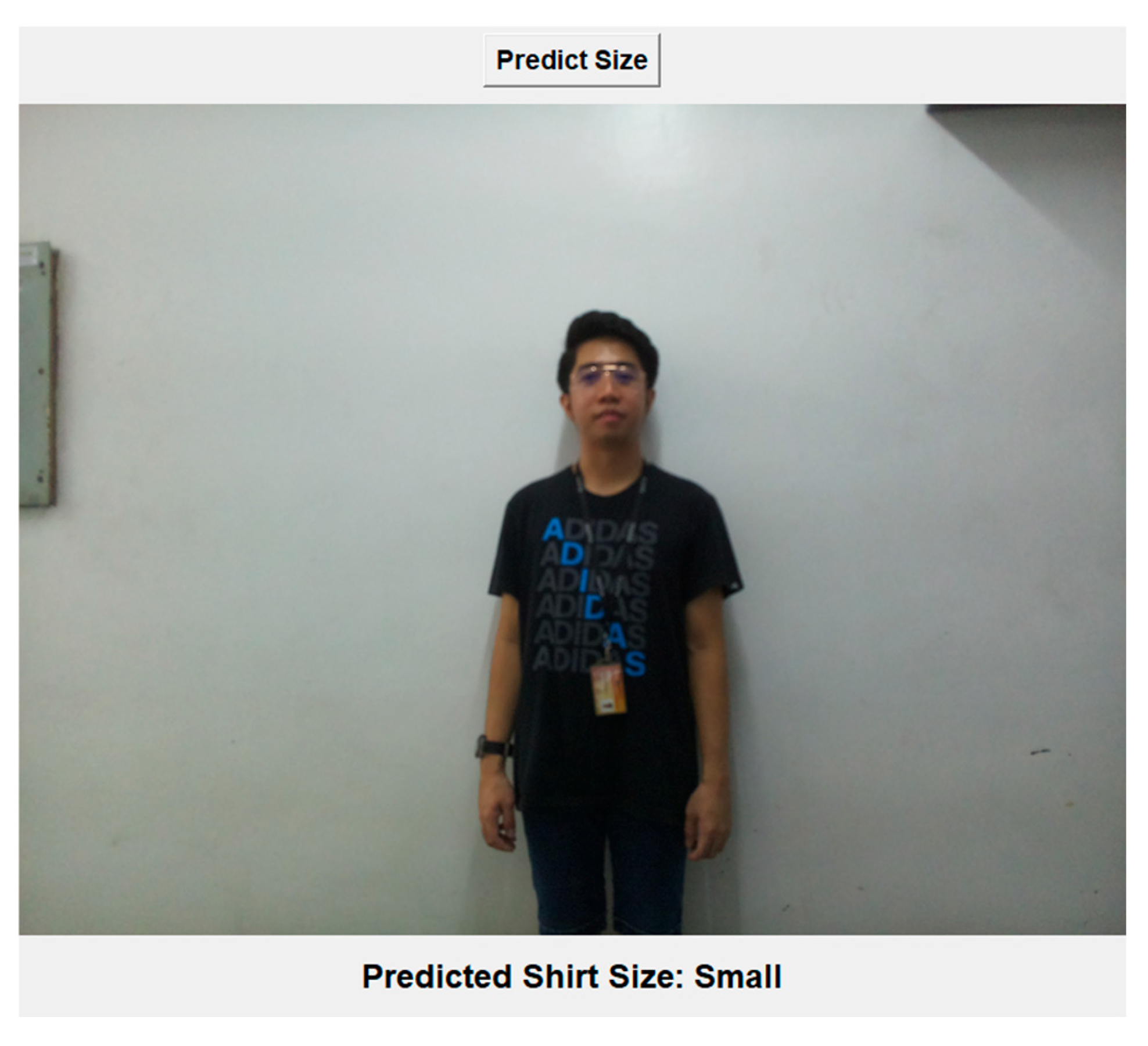Cotton T-Shirt Size Estimation Using Convolutional Neural Network †
Abstract
1. Introduction
2. Methodology
2.1. Hardware
2.2. Software Development
2.3. Experimental Setup
2.4. Data Gathering
3. Results and Discussions
4. Conclusion and Recommendation
Author Contributions
Funding
Institutional Review Board Statement
Informed Consent Statement
Data Availability Statement
Conflicts of Interest
References
- Mohamad, S.R.; Zainuddin, S.A.; Hashim, N.A.A.N.; Abdullah, T.; Anuar, N.I.M.; Deraman, S.N.S.; Azmi, N.F.; Razali, N.A.M.; Zain, E.N.M. Validating the measuring instrument for the determinants of social commerce shopping intention among teenagers. Eur. J. Mol. Clin. Med. 2020, 7, 1877–1881. [Google Scholar]
- Li, Y.; Shu, H. Research on Online Interaction and Consumer Impulsive Buying Behavior in Live Shopping Platform Based on the Structural Equation Model. In Proceedings of the 2021 International Conference on Management Science and Software Engineering (ICMSSE), Chengdu, China, 9–11 July 2021; pp. 72–76. [Google Scholar]
- Berthene, A. Sizing Issue Is a Top Reason Shoppers Return Online Orders. Available online: https://www.digitalcommerce360.com/2019/09/12/sizing-issue-is-a-top-reason-shoppers-return-online-orders/ (accessed on 12 September 2019).
- Dewan, D.; Chapain, B.; Jaiswal, M.; Kumar, S. Estimate human body measurement from 2D image using computer vision. J. Emerg. Technol. Innov. Res. 2022, 9, 438–445. [Google Scholar]
- Ashmawi, S.; Alharbi, M.; Almaghrabi, A.; Alhothali, A. Fitme: Body Measurement Estimations Using Machine Learning Method. Procedia Comput. Sci. 2019, 163, 209–217. [Google Scholar] [CrossRef]
- Jawad, H.M.; Husain, T.A. Measuring Object Dimensions and Its Distances Based on Image Processing Technique by Analysis the Image Using Sony Camera. Eurasian J. Sci. Eng. 2017, 3, 100–110. [Google Scholar] [CrossRef]
- Othman, N.A.; Salur, M.U.; Karakose, M.; Aydin, I. An Embedded Real-Time Object Detection and Measurement of its Size. In Proceedings of the 2018 International Conference on Artificial Intelligence and Data Processing (IDAP), Malatya, Turkey, 28–30 September 2018; pp. 1–4. [Google Scholar]
- Thota, K.S.P.; Suh, S.; Zhou, B.; Lukowicz, P. Estimation of 3d Body Shape And Clothing Measurements From Frontal-And Side-View Images. In Proceedings of the 2022 IEEE International Conference on Image Processing (ICIP), Bordeaux, France, 16–19 October 2022; pp. 2631–2635. [Google Scholar]
- Aly, S.; Abdallah, A.; Sherif, S.; Atef, A.; Adel, R.; Hatem, M. Toward Smart Internet of Things (IoT) for Apparel Retail Industry: Automatic Customer’s Body Measurements and Size Recommendation System using Computer Vision Techniques. In Proceedings of the 2021 Second International Conference on Intelligent Data Science Technologies and Applications (IDSTA), Tartu, Estonia, 15–17 November 2021; pp. 99–104. [Google Scholar]
- Nijjar, R.K.; Tan, J.R.G.; Linsangan, N.B.; Adtoon, J.J. Valgus and Varus Disease Detection using Image Processing. In Proceedings of the 2020 IEEE 12th International Conference on Humanoid, Nanotechnology, Information Technology, Communication and Control, Environment, and Management (HNICEM), Manila, Philippines, 3–7 December 2020; pp. 1–6. [Google Scholar]
- Gong, X.-Y.; Su, H.; Xu, D.; Zhang, Z.-T.; Shen, F.; Yang, H.-B. An Overview of Contour Detection Approaches. Int. J. Autom. Comput. 2018, 15, 656–672. [Google Scholar] [CrossRef]
- Yang, D.; Peng, B.; Al-Huda, Z.; Malik, A.; Zhai, D. An overview of edge and object contour detection. Neurocomputing 2022, 488, 470–493. [Google Scholar] [CrossRef]
- Singh, D.; Panthri, S.; Venkateshwari, P. Human Body Parts Measurement using Human Pose Estimation. In Proceedings of the 2022 9th International Conference on Computing for Sustainable Global Development (INDIACOM), New Delhi, India, 23–25 March 2022; pp. 288–292. [Google Scholar]
- Sutayco, M.J.Y.; Caya, M.V.C. Identification of Medicinal Mushrooms using Computer Vision and Convolutional Neural Network. In Proceedings of the 2022 6th International Conference on Electrical, Telecommunication and Computer Engineering (ELTICOM), Medan, Indonesia, 22–23 November 2022; pp. 167–171. [Google Scholar]
- Macawile, M.J.; Quinones, V.V.; Ballado, A.; Cruz, J.D.; Caya, M.V. White blood cell classification and counting using convolutional neural network. In Proceedings of the 2018 3rd International Conference on Control and Robotics Engineering (ICCRE), Nagoya, Japan, 20–23 April 2018; pp. 259–263. [Google Scholar]
- Buenconsejo, L.T.; Linsangan, N.B. Classification of Healthy and Unhealthy Abaca leaf using a Convolutional Neural Network (CNN). In Proceedings of the 2021 IEEE 13th International Conference on Humanoid, Nanotechnology, Information Technology, Communication and Control, Environment, and Management (HNICEM), Manila, Philippines, 28–30 November 2021; pp. 1–5. [Google Scholar]
- Muhali, A.S.; Linsangan, N.B. Classification of Lanzones Tree Leaf Diseases Using Image Processing Technology and a Convolutional Neural Network (CNN). In Proceedings of the 2022 IEEE International Conference on Artificial Intelligence in Engineering and Technology (IICAIET), Kota Kinabalu, Malaysia, 13–15 September 2022; pp. 1–6. [Google Scholar]
- Elabbas, A.I.; Khan, K.K.; Hortinela, C.C. Classification of Otitis Media Infections using Image Processing and Convolutional Neural Network. In Proceedings of the 2021 IEEE 13th International Conference on Humanoid, Nanotechnology, Information Technology, Communication and Control, Environment, and Management (HNICEM), Manila, Philippines, 28–30 November 2021; pp. 1–6. [Google Scholar]
- Padilla, D.; Yumang, A.; Diaz, A.L.; Inlong, G. Differentiating Atopic Dermatitis and Psoriasis Chronic Plaque Using Convolutional Neural Network MobileNet Architecture. In Proceedings of the 2019 IEEE 11th International Conference on Humanoid, Nanotechnology, Information Technology, Communication and Control, Environment, and Management (HNICEM), Laoag, Philippines, 29 November01 December 2019; pp. 1–6. [Google Scholar]
- Fajardo, K.C.; Gonzales, J.S.; Iv, C.C.H. Detection and Identification of Intestinal Parasites on Dogs Using AlexNet CNN Architecture. In Proceedings of the 2022 IEEE International Conference on Artificial Intelligence in Engineering and Technology (IICAIET), Kota Kinabalu, Malaysia, 13–15 September 2022; pp. 1–6. [Google Scholar]
- Caya, M.V.C.; Maramba, R.G.; Mendoza, J.S.D.; Suman, P.S. Characterization and Classification of Coffee Bean Types Using Support Vector Machine. In Proceedings of the 2020 IEEE 12th International Conference on Humanoid, Nanotechnology, Information Technology, Communication and Control, Environment, and Management (HNICEM), Manila, Philippines, 3–7 December 2020; pp. 1–6. [Google Scholar]
- Magadia, A.P.I.D.; Zamora, R.F.G.L.; Linsangan, N.B.; Angelia, H.L.P. Bimodal Hand Vein Recognition System Using Support Vector Machine. In Proceedings of the 2020 IEEE 12th International Conference on Humanoid, Nanotechnology, Information Technology, Communication and Control, Environment, and Management (HNICEM), Manila, Philippines, 3–7 December 2020; pp. 1–5. [Google Scholar]
- Padilla, D.A.; Magwili, G.V.; Marohom, A.L.A.; Co, C.M.G.; Gano, J.C.C.; Tuazon, J.M.U. Portable Yellow Spot Disease Identifier on Sugarcane Leaf via Image Processing Using Support Vector Machine. In Proceedings of the 2019 5th International Conference on Control, Automation and Robotics (ICCAR), Beijing, China, 19–22 April 2019; pp. 901–905. [Google Scholar]
- Mateo, K.C.H.; Navarro, L.K.B.; Manlises, C.O. Identification of Macro-Nutrient Deficiency in Onion Leaves (Allium cepa L.) Using Convolutional Neural Network (CNN). In Proceedings of the 2022 5th International Seminar on Research of Information Technology and Intelligent Systems (ISRITI), Yogyakarta, Indonesia, 8–9 December 2022; pp. 419–424. [Google Scholar]










| Small | Medium | Large | Extra-Large | Double Extra-Large | |
|---|---|---|---|---|---|
| Chest Width (inches) | 18.5 | 20 | 21.5 | 23 | 24.5 |
| Shoulder Width (inches) | 18 | 19 | 20 | 21 | 22 |
| N = 30 | Predicted Class | Total | |||||
|---|---|---|---|---|---|---|---|
| Small | Medium | Large | Extra Large | Double XL | |||
| Actual Class | Small | 4 | 0 | 0 | 0 | 0 | 4 |
| Medium | 1 | 5 | 1 | 0 | 0 | 7 | |
| Large | 0 | 2 | 4 | 0 | 0 | 6 | |
| Extra Large | 0 | 0 | 4 | 3 | 0 | 7 | |
| Double XL | 0 | 0 | 0 | 1 | 5 | 6 | |
| Total | 4 | 7 | 9 | 4 | 5 | 21 out of 30 | |
Disclaimer/Publisher’s Note: The statements, opinions and data contained in all publications are solely those of the individual author(s) and contributor(s) and not of MDPI and/or the editor(s). MDPI and/or the editor(s) disclaim responsibility for any injury to people or property resulting from any ideas, methods, instructions or products referred to in the content. |
© 2025 by the authors. Licensee MDPI, Basel, Switzerland. This article is an open access article distributed under the terms and conditions of the Creative Commons Attribution (CC BY) license (https://creativecommons.org/licenses/by/4.0/).
Share and Cite
Alfonso, J.K.D.; Casumpang, C.J.G.; Villaverde, J.F. Cotton T-Shirt Size Estimation Using Convolutional Neural Network. Eng. Proc. 2025, 92, 44. https://doi.org/10.3390/engproc2025092044
Alfonso JKD, Casumpang CJG, Villaverde JF. Cotton T-Shirt Size Estimation Using Convolutional Neural Network. Engineering Proceedings. 2025; 92(1):44. https://doi.org/10.3390/engproc2025092044
Chicago/Turabian StyleAlfonso, John King D., Ckyle Joshua G. Casumpang, and Jocelyn F. Villaverde. 2025. "Cotton T-Shirt Size Estimation Using Convolutional Neural Network" Engineering Proceedings 92, no. 1: 44. https://doi.org/10.3390/engproc2025092044
APA StyleAlfonso, J. K. D., Casumpang, C. J. G., & Villaverde, J. F. (2025). Cotton T-Shirt Size Estimation Using Convolutional Neural Network. Engineering Proceedings, 92(1), 44. https://doi.org/10.3390/engproc2025092044






